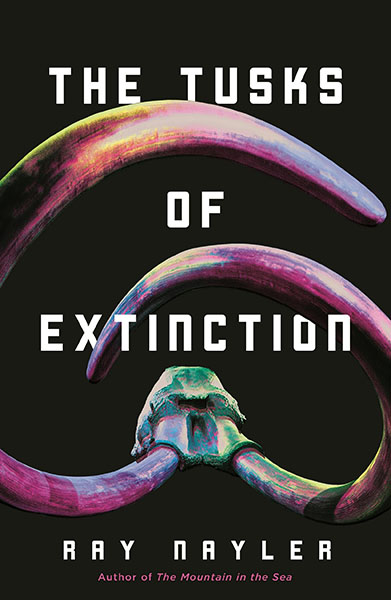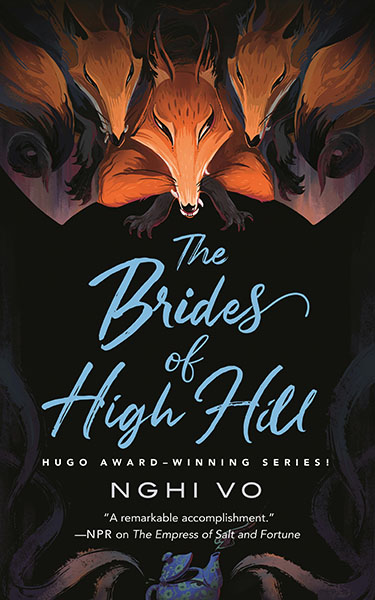I’ve got about eighteen weeks to post reviews of twenty-four Hugo Award nominees in the main fiction categories (well, twenty-one, since I’ve already reviewed one novel and two novellas), so I’m gonna start with a two-fer. This week’s review is for Ray Nayler’s haunting novella of memory and war, and another adventure featuring Nghi Vo’s Singing Hills cleric.
The Tusks of Extinction – Ray Nayler
“Extinction has only one cause, and that cause is older, even, than the wheel. That cause is human greed.”
It’s a grim situation that Nayler is portraying in this novella, and it’s based on a situation we’re already dealing with: animals that are treasured in two entirely different ways. The story features the attempts to bring mammoths back to life – and to the wild – but the project’s origin comes from the never-ending war to save the elephants. Or to harvest them, depending on which side you’re fighting for.

We’d all like to think that at some point everyone involved in elephant poaching (or rhino poaching, or <insert name of next animal on the endangered list>) will eventually realize that they have to stop hunting them or there won’t be any more ivory. Ever. But…that’s never going to happen. And I think everyone knows it. As long as there are any animals left, there will always be someone with enough money to pay for someone desperate enough to break all the rules and kill it. And kill the people getting in the way. Doesn’t matter if it’s a few elephants in the wild, a couple of breeding pairs in a preserve, or one last survivor growing old in a zoo, the very fact that they’re the last we’ll ever have just makes them worth more money, and more violence.
Now just imagine what people would be willing to do if it wasn’t elephants that are worth all this, but mammoths.
“All of them are cut-and-paste, genetic chimeras built from a scaffolding of modern animals, gestated in modern wombs, fostered by distant cousins – but they are close enough.
The chapters switch between several viewpoints: a woman who’s spent her life trying to protect elephants from poachers. A teenage boy who’s father has dragged him along on a poaching mission. Two scientists trying to keep a struggling mammoth preserve going. A man who’s wealthy big-game-hunting husband is after the biggest, rarest game there is. All of them have their own way of seeing the world, through poverty or wealth, through a doomed mission that has to be fought anyway, through hope that requires choices between several very bad options.
But this is much more than just a good humans vs bad humans here, because one of the viewpoints is doubled. Dr. Damira Khismatullina didn’t survive her war against the poachers. And as the foremost expert on elephants, her consciousness is the only way to help the newly-resurrected mammoth species remember how to be mammoths.
This story asks a lot of very hard questions, not just about what we’re prepared to do to save what’s left of a species, but whether we’re prepared to make compromises with the same people who caused the animals to become endangered in the first place. And whether those compromises are actually betrayals. Just what does that say about a person if they’re willing to pay to the privilege of killing something that most people will never see in real life?
And this was perhaps the greatest power of all: to kill something that no one else could kill. To have a miracle resurrected – and then destroy it.
The story isn’t entirely grim, because Naylor weaves lovely threads of beauty in amongst all of this violence and despair. The nature of elephants – and by extension mammoths – means that they live their memories as they’re remembering them. And Damira’s memories are of both her human life and her new life in a mammoth’s body, so there are cinematic moments as she and her new family stride across the plains while visions of her childhood bedroom, her long-gone friends, and the loving uncle who accidentally inspired her life’s work, all spread out around her in an ever-changing display as every scent she comes across triggers new memories.
This story isn’t a blueprint for how to do things like restore the ecosystem, or stop the exploitation of the natural world. In fact for all that the ending feels very hopeful, it also feels like there’s a note of caution in there. As humans, it’s all too easy for us to be cut off from our origins, or our empathy. And we’re only going to have the energy to fight back if we reconnect ourselves to all of it and actually care about the outcome. Even if that hurts.
The Brides of High Hill – Nghi Vo
“The world starts with a story. So do dynasties and eras and wars. So does love, and so does revenge. Everything starts with a story.”
The fifth book in Nghi Vo’s Singing Hills Cycle finds wandering story-collector Cleric Thien teaming up with a young woman who’s traveling with her family to meet her prospective – and very wealthy – bridegroom, Lord Guo. Pham Nhung is beautiful, and adventurous, and a little bossy but in a charming way, and she’s putting on a brave face in hopes that her marriage will lift the Pham family’s status. Happiness is obviously not a guarantee, but she’s hopeful about that too.

Cleric Thien feels more and more protective of her as they settle in to Lord Guo’s sprawling walled estate of Doi Cao. Lord Guo seems happy with his potential bride, there are feasts every day and extravagant displays for the guests, like an entire courtyard temporarily turned into a candy fantasy. It’s all very wonderful. It’s just that things feel slightly…off. The exhausted servants are all deliberately Not Saying Things. There’s a relative who’s either mad or cursed. Worst of all, it’s becoming very clear that Lord Guo is keeping secrets. And also that he’s terrifying.
It could be respect, I suppose, but fear’s heavier and this feels like fear.
There are multiple mysteries going on here. And Nghi Vo knows how to play with the rules of stories themselves to tell a different story from the main one. The creeping sense of dread leads to some startlingly nightmarish images. In a series that’s included war, generational betrayals, and coping with grief, this is definitely the darkest.
And you know what? It’s also my favorite. I enjoyed the heck out of this one. It’s just so extravagantly weird, I was grinning my head off even when wondering exactly how many of the characters were going to make it out alive.